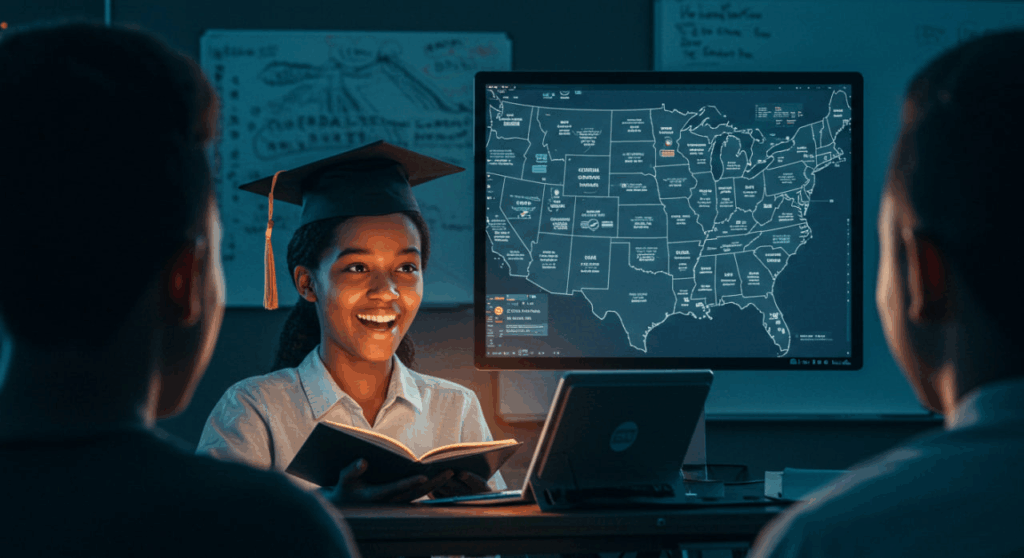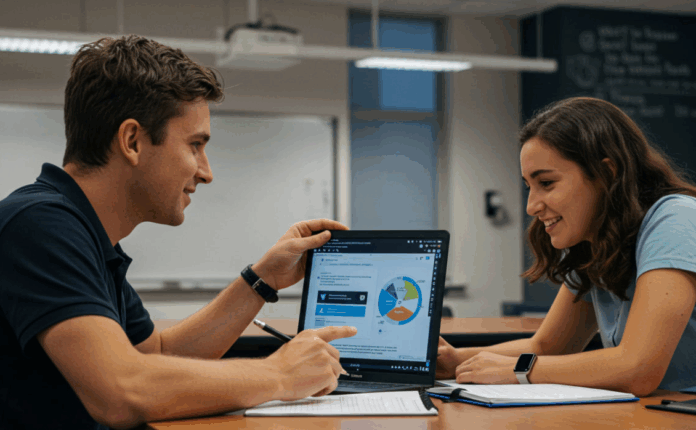Education is the cornerstone of progress, shaping the minds that will lead America into a dynamic future. As we step into 2025, the landscape of education is evolving rapidly, driven by technological advancements, shifting societal needs, and a renewed focus on equity and inclusion. This blog post examines how innovative policies, cutting-edge technologies, and community-driven initiatives are transforming education in the United States, laying the groundwork for a brighter, more inclusive future. From reimagining classroom experiences to fostering lifelong learning, the journey to educate America is both inspiring and essential.
The State of Education in 2025
A New Era of Learning
The American education system in 2025 is at a pivotal moment. Schools and universities are adapting to a world where digital literacy is as crucial as traditional reading and writing. Classrooms are no longer confined to four walls; they are vibrant ecosystems blending in-person and virtual learning. Hybrid models, bolstered by advancements in AI and virtual reality, allow students to explore complex concepts through immersive simulations, from dissecting virtual ecosystems to walking through historical events. This shift is not just about technology—it’s about creating engaging, personalized experiences that spark curiosity and foster critical thinking.
Addressing Equity and Access
Despite these advancements, equity remains a critical challenge. In 2025, policymakers and educators are prioritizing access to quality education for all, particularly for underserved communities. Initiatives such as nationwide broadband expansion and subsidized technology programs ensure that students in rural and low-income areas can access digital learning opportunities. Scholarships and grants are also being expanded to support a diverse range of students pursuing higher education. By addressing systemic barriers, the United States is working to ensure that every child, regardless of background, has the tools to succeed.
Innovations Driving Educational Progress
Technology as a Catalyst
Technology is revolutionizing the delivery of education. Artificial intelligence platforms, such as adaptive learning systems, tailor lessons to individual student needs, identifying strengths and weaknesses in real-time. For example, a student struggling with algebra can receive customized exercises, while another excelling in literature might be challenged with advanced texts. Virtual reality (VR) is also making waves, enabling students to explore distant planets or historical civilizations in ways that textbooks cannot match. These tools make learning interactive and accessible, preparing students for a tech-driven world.
The Rise of Lifelong Learning
In 2025, education doesn’t end with a diploma. The rapid pace of technological necessitates lifelong learning.. Community colleges and online platforms are offering microcredentials and short courses to help adults upskill in fields such as cybersecurity, renewable energy, and data science. Companies are partnering with educational institutions to create pathways for employees to gain new skills, ensuring America’s workforce remains competitive. This culture of continuous learning empowers individuals to adapt and thrive in an ever-evolving economy.
Policy and Community: A Collaborative Effort
National Campaigns for Education Reform
National campaigns in 2025 are rallying support for education reform, emphasizing innovation and inclusivity. Federal and state governments are investing in teacher training programs to equip educators with the skills to integrate technology effectively. Policies are also focusing on mental health support in schools, recognizing that emotional well-being is critical to academic success. These campaigns unite educators, parents, and policymakers in a shared vision of an education system that prepares students for both personal and professional success.

Community-Driven Solutions
Communities are stepping up to support education in creative ways. Local nonprofits and businesses are funding after-school programs that teach coding, robotics, and entrepreneurship. Parent-led initiatives are advocating for inclusive curricula that reflect diverse histories and perspectives. In cities and small towns alike, community centers are becoming hubs for learning, offering workshops and resources for students and families. These grassroots efforts ensure that education is a collective responsibility, not just the domain of schools. and institutions
Challenges and Opportunities Ahead
Bridging the Digital Divide
While technology offers incredible opportunities, the digital divide remains a significant hurdle. In 2025, efforts to provide affordable internet and devices are crucial to ensuring that no student is left behind. Public-private partnerships are key, with companies donating laptops and schools offering digital literacy training for parents. By closing this gap, America can create a truly inclusive education system where every student has access to the tools they need to succeed.
Preparing for a Changing Workforce
The job market of 2025 demands skills that didn’t exist a decade ago. Schools are responding by integrating STEM (science, technology, engineering, and math) education with soft skills, such as collaboration and problem-solving. Career and technical education (CTE) programs are expanding, offering hands-on training in fields like green energy and healthcare. These programs prepare students for immediate employment while fostering adaptability for future challenges.
A Vision for the Future
As America looks to 2025 and beyond, education is more than just a pathway to a career—it’s a foundation for a thriving society. By embracing innovation, prioritizing equity, and fostering collaboration, the nation is building an education system that empowers every individual to reach their potential. The journey is far from over, but with collective effort, America is laying the groundwork for a brighter, more inclusive future where education is the key to opportunity.
FAQ
What are the biggest challenges facing American education in 2025?
The biggest challenges include bridging the digital divide, ensuring equitable access to quality education, and preparing students for a rapidly changing job market. Addressing these requires investment in technology, teacher training, and inclusive policies.
How is technology changing education in 2025?
Technology is transforming education through AI-driven adaptive learning, virtual reality experiences, and online platforms that facilitate lifelong learning. These tools personalize education, making it more interactive and accessible.
What role do communities play in education reform?
Communities play a vital role in supporting education through after-school programs, funding initiatives, and advocacy for inclusive curricula. Local efforts complement national policies to create a comprehensive approach to education.
How can I support education in my community?
You can support education by volunteering at local schools, donating to educational nonprofits, or advocating for policies that promote equity and access. Engaging with community centers and parent groups is also a great way to make a meaningful contribution.



